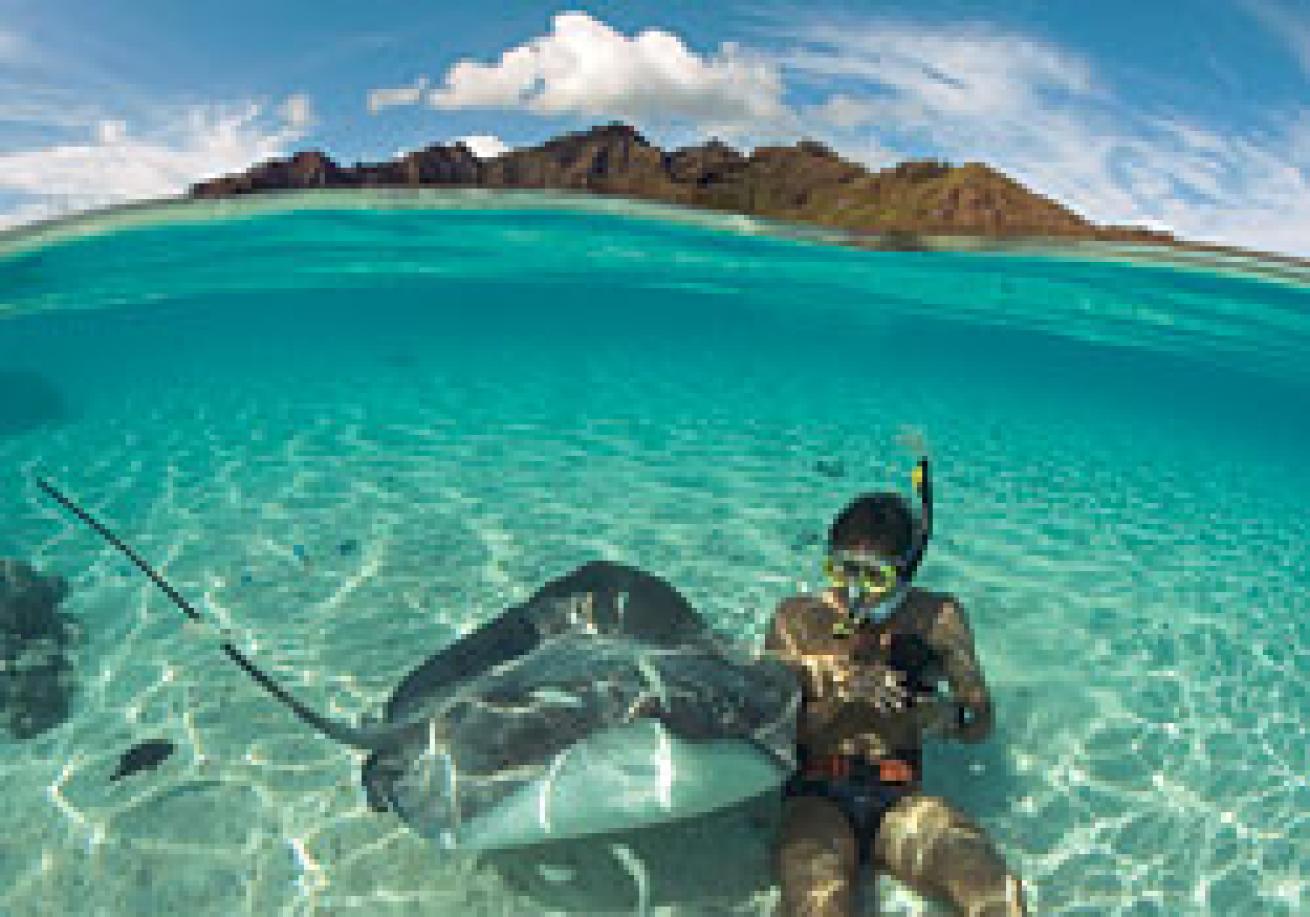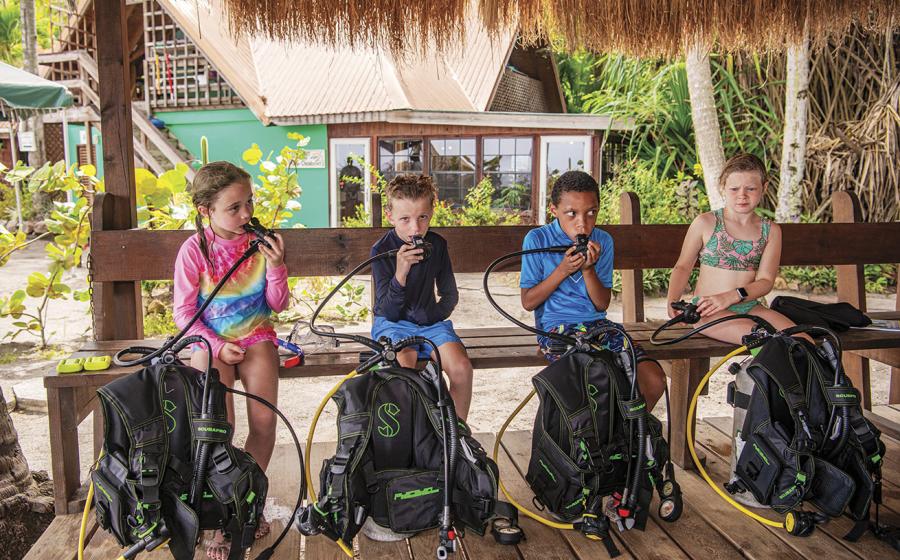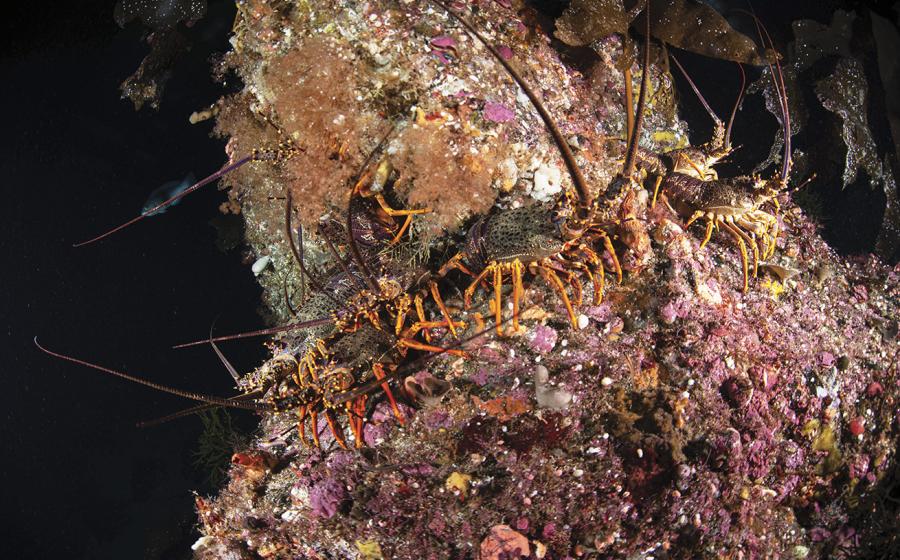Shooting with Natural Light

January 2007
Text and Photography by Stephen Frink
It's widely known that in order to capture color in underwater photography, you have to use artificial light. That is not exactly true, of course, because in very shallow water you can get some color in your photos without using strobe light. Digital seems to do a better job than film in recording whatever colors exist after the selective filtration of the water, but without a strobe you can expect the colors to become very muted at normal diving depths. Reds begin to fade in only 10 feet of water, and by 25 feet or so the yellows have diminished. At just 40 feet not much is left to show up on your images other than shades of blue and black.
Yet, images taken without the benefit of artificial light, known alternatively as available-light and ambient-light photography, can be extraordinarily striking. The trick is to know under which circumstances available-light imaging might work, and how to maximize the results. Here are a few instances when you can leave the strobes on the boat.
Shooting Over/Unders
Both the above-water and underwater portions of the photo are recorded in ambient light when shooting over/unders. Typically, an extremely wide-angle lens like a full-frame fisheye is used behind the widest possible dome port in an underwater housing. The air/water interface bisects the composition. Ideally, something of interest will occupy both the topside and underwater portion of the composition.
Another way to shoot splits includes the use of a custom diopter that screw-mounts over the lens, behind the dome port. The common configuration is a one-stop neutral-density filter on the top (to cut down the light above water to match the amount of light lost underwater due to reflection and absorption). The bottom portion of the custom filter is typically a +2 diopter. This allows the lens to be focused at a greater distance for the topside subject, yet underwater the close-up lens will pull the focus back near enough so the lens can register on the dome's virtual image.
However, the split diopter requires shooting all verticals or all horizontals during the session because the filter can't be rotated inside the housing. It also requires slick-calm conditions so that the photographer can use the water interface to obscure the joint between the neutral-density filter and the diopter. There are no commercially available split diopters at the moment, so photographers typically have to find an eye doctor willing to craft one for them. Using a split filter also requires that the image be split exactly in half, half above and half below.
All that being said, the actual execution of the over/under isn't difficult. I like to use the shutter speed priority setting on my camera. I pick a shutter speed high enough to stop any camera motion or action in the subject, usually about 1/200 of a second. Generally, there is plenty of ambient light on the scene for a low ISO setting, but if I need a smaller aperture to enhance depth of field, I might kick up the ISO to 200 or even 400. In modern digital cameras the higher ISOs remain great performers, so there is no real downside to moderately higher ISO if it enhances probability of focus. As for autofocus, I use the camera's ability to shift a particular zone of autofocus detection so I can pick out whichever subject is most important, whether it be above or below the surface.
A focus gear on the wide-angle lens allows for fudging a little on the focal point, kind of compromising between what is required of the topside and underwater sweet spot so that depth of field will bring both into focus. Also, with moving subjects, a prefocused zone permits rapid motordrive sequences, useful for giant-stride entry shots and the like.
Photographing Big Wildlife
Sometimes, with some critters, using ambient light is your best choice. Shooting humpbacks in Hawaii, the Silver Bank or Tonga, the water is generally clear enough to use strobes without having lots of backscatter in the shot, but the mammals are so large that even with a 180-degree lens the shooter usually needs to be more than 10 feet away. This is beyond the range of effective strobe lighting. The more significant reality is that these creatures are skittish and it is a rare opportunity when a photographer can sneak closer than 10 feet.
In some places, photographers aren't even allowed to use strobe for some creatures. The whale sharks encountered in Western Australia may be photographed only in available light, which is also true of the minke whales seasonally encountered off Queensland.
Then there are situations with quickly moving subjects, like the spotted dolphins off Grand Bahama's West End. Their effortless grace in the water can propel them far faster than any of us can swim, and the extra water resistance and weight of a submersible strobe and arm may make the whole situation unnecessarily aerobic and possibly counterproductive.
Setting a Mood
Sometimes you need to show the big picture, photographing a large structure from a distance. This can set the mood for a photo essay, and then tighter shots, generally taken with strobe, can add vignettes to complete the story. The day after the Duane shipwreck went down in Key Largo was extraordinary--150-foot visibility and slick-calm seas. The wreck was sitting perfectly upright in 120 feet of water, and as I descended to 30 feet, I just had to stop and wonder at the scene. Here was the ship, still all white and fresh, emerging as a ghostly apparition through the blue. I snapped a few ambient-light shots and even today these remain my favorite shots of the Duane. She was never as clean and white as that first day, and even though I have dived the wreck in stellar water clarity many times since, all the coral encrustation mutes the contrast between the ship and the sea. That is one shot I can never replicate again.

January 2007
Text and Photography by Stephen Frink
It's widely known that in order to capture color in underwater photography, you have to use artificial light. That is not exactly true, of course, because in very shallow water you can get some color in your photos without using strobe light. Digital seems to do a better job than film in recording whatever colors exist after the selective filtration of the water, but without a strobe you can expect the colors to become very muted at normal diving depths. Reds begin to fade in only 10 feet of water, and by 25 feet or so the yellows have diminished. At just 40 feet not much is left to show up on your images other than shades of blue and black.
Yet, images taken without the benefit of artificial light, known alternatively as available-light and ambient-light photography, can be extraordinarily striking. The trick is to know under which circumstances available-light imaging might work, and how to maximize the results. Here are a few instances when you can leave the strobes on the boat.
Shooting Over/Unders
Both the above-water and underwater portions of the photo are recorded in ambient light when shooting over/unders. Typically, an extremely wide-angle lens like a full-frame fisheye is used behind the widest possible dome port in an underwater housing. The air/water interface bisects the composition. Ideally, something of interest will occupy both the topside and underwater portion of the composition.
Another way to shoot splits includes the use of a custom diopter that screw-mounts over the lens, behind the dome port. The common configuration is a one-stop neutral-density filter on the top (to cut down the light above water to match the amount of light lost underwater due to reflection and absorption). The bottom portion of the custom filter is typically a +2 diopter. This allows the lens to be focused at a greater distance for the topside subject, yet underwater the close-up lens will pull the focus back near enough so the lens can register on the dome's virtual image.
However, the split diopter requires shooting all verticals or all horizontals during the session because the filter can't be rotated inside the housing. It also requires slick-calm conditions so that the photographer can use the water interface to obscure the joint between the neutral-density filter and the diopter. There are no commercially available split diopters at the moment, so photographers typically have to find an eye doctor willing to craft one for them. Using a split filter also requires that the image be split exactly in half, half above and half below.
All that being said, the actual execution of the over/under isn't difficult. I like to use the shutter speed priority setting on my camera. I pick a shutter speed high enough to stop any camera motion or action in the subject, usually about 1/200 of a second. Generally, there is plenty of ambient light on the scene for a low ISO setting, but if I need a smaller aperture to enhance depth of field, I might kick up the ISO to 200 or even 400. In modern digital cameras the higher ISOs remain great performers, so there is no real downside to moderately higher ISO if it enhances probability of focus. As for autofocus, I use the camera's ability to shift a particular zone of autofocus detection so I can pick out whichever subject is most important, whether it be above or below the surface.
A focus gear on the wide-angle lens allows for fudging a little on the focal point, kind of compromising between what is required of the topside and underwater sweet spot so that depth of field will bring both into focus. Also, with moving subjects, a prefocused zone permits rapid motordrive sequences, useful for giant-stride entry shots and the like.
Photographing Big Wildlife
Sometimes, with some critters, using ambient light is your best choice. Shooting humpbacks in Hawaii, the Silver Bank or Tonga, the water is generally clear enough to use strobes without having lots of backscatter in the shot, but the mammals are so large that even with a 180-degree lens the shooter usually needs to be more than 10 feet away. This is beyond the range of effective strobe lighting. The more significant reality is that these creatures are skittish and it is a rare opportunity when a photographer can sneak closer than 10 feet.
In some places, photographers aren't even allowed to use strobe for some creatures. The whale sharks encountered in Western Australia may be photographed only in available light, which is also true of the minke whales seasonally encountered off Queensland.
Then there are situations with quickly moving subjects, like the spotted dolphins off Grand Bahama's West End. Their effortless grace in the water can propel them far faster than any of us can swim, and the extra water resistance and weight of a submersible strobe and arm may make the whole situation unnecessarily aerobic and possibly counterproductive.
Setting a Mood
Sometimes you need to show the big picture, photographing a large structure from a distance. This can set the mood for a photo essay, and then tighter shots, generally taken with strobe, can add vignettes to complete the story. The day after the Duane shipwreck went down in Key Largo was extraordinary--150-foot visibility and slick-calm seas. The wreck was sitting perfectly upright in 120 feet of water, and as I descended to 30 feet, I just had to stop and wonder at the scene. Here was the ship, still all white and fresh, emerging as a ghostly apparition through the blue. I snapped a few ambient-light shots and even today these remain my favorite shots of the Duane. She was never as clean and white as that first day, and even though I have dived the wreck in stellar water clarity many times since, all the coral encrustation mutes the contrast between the ship and the sea. That is one shot I can never replicate again.






